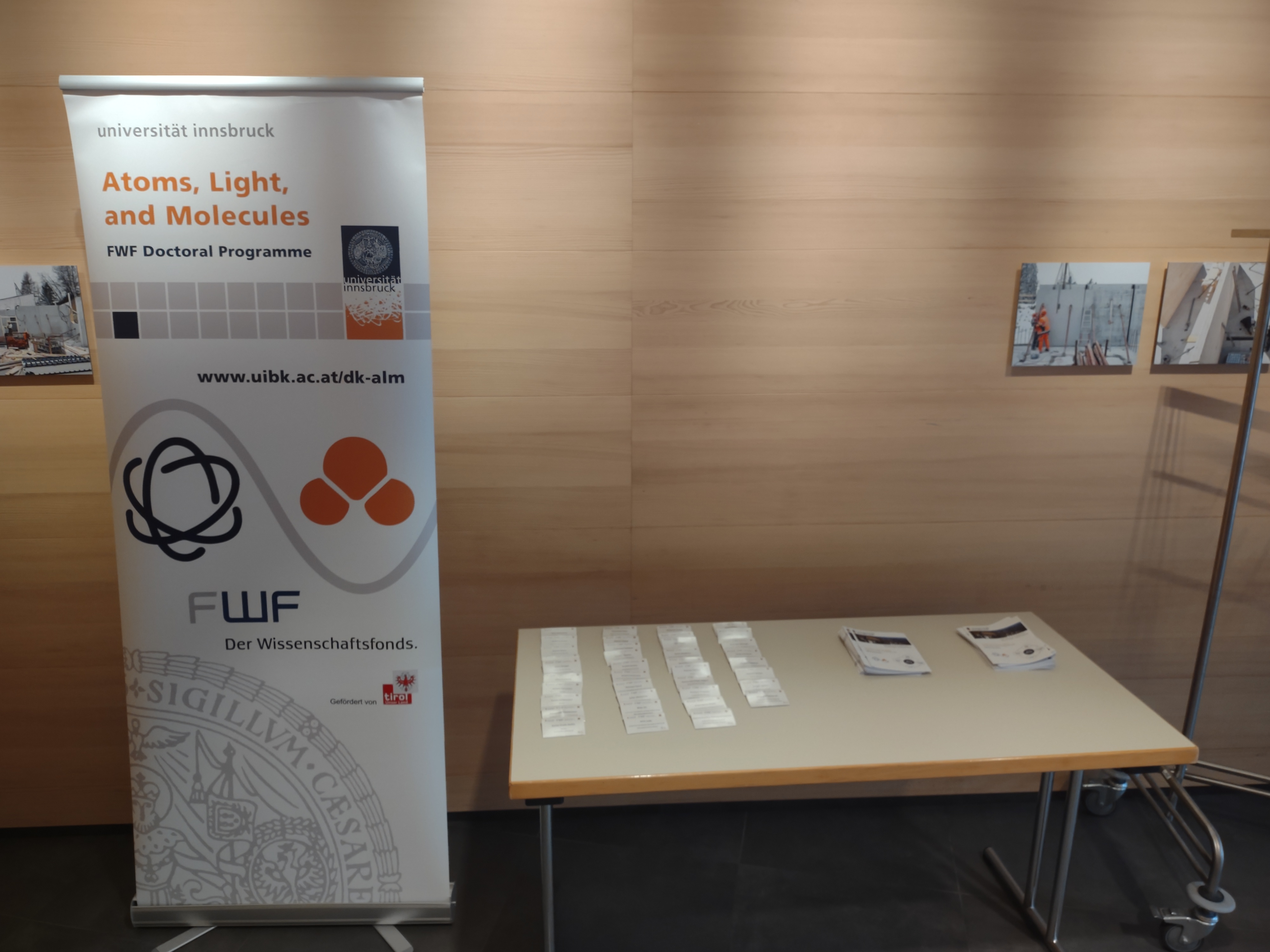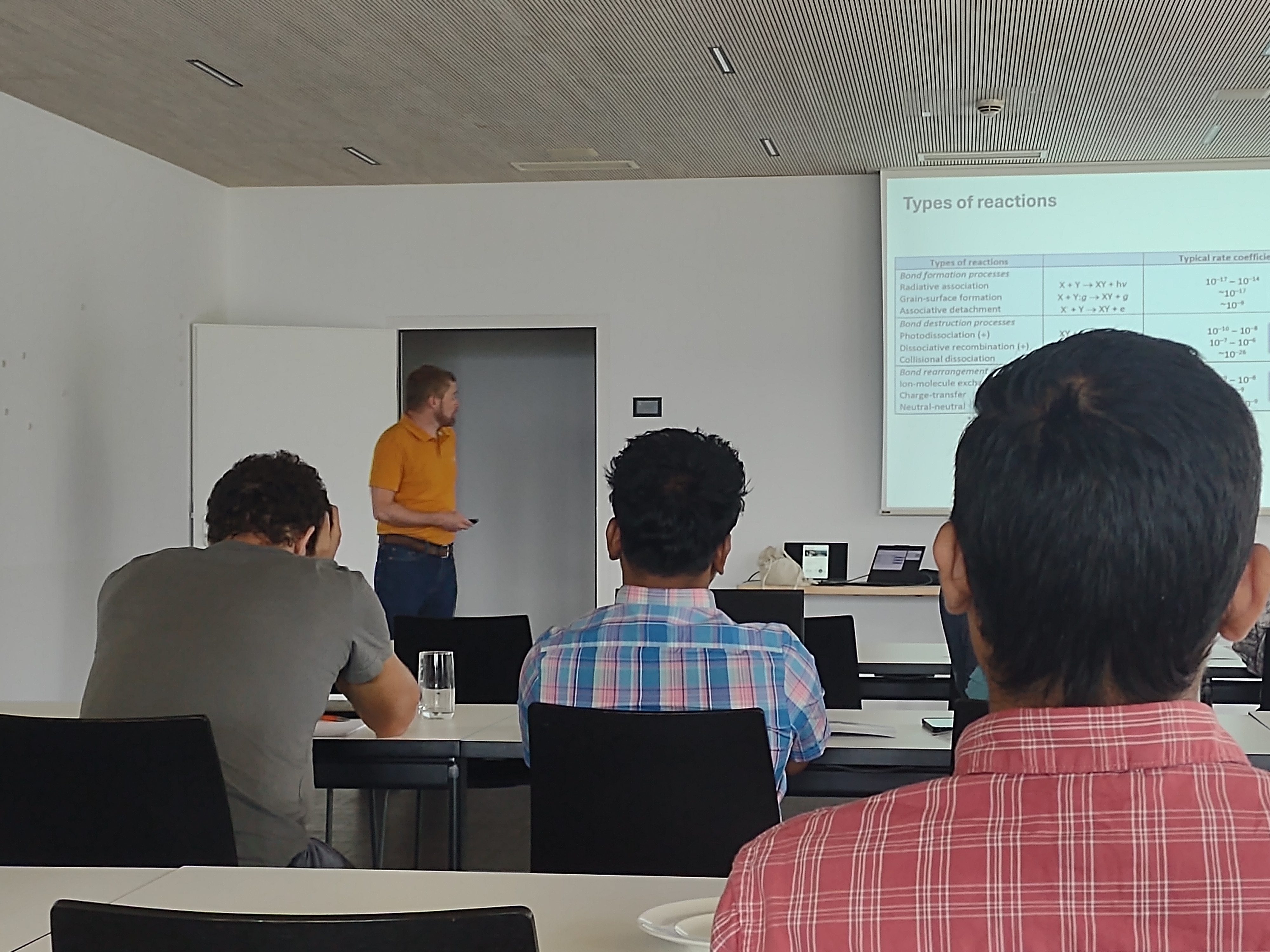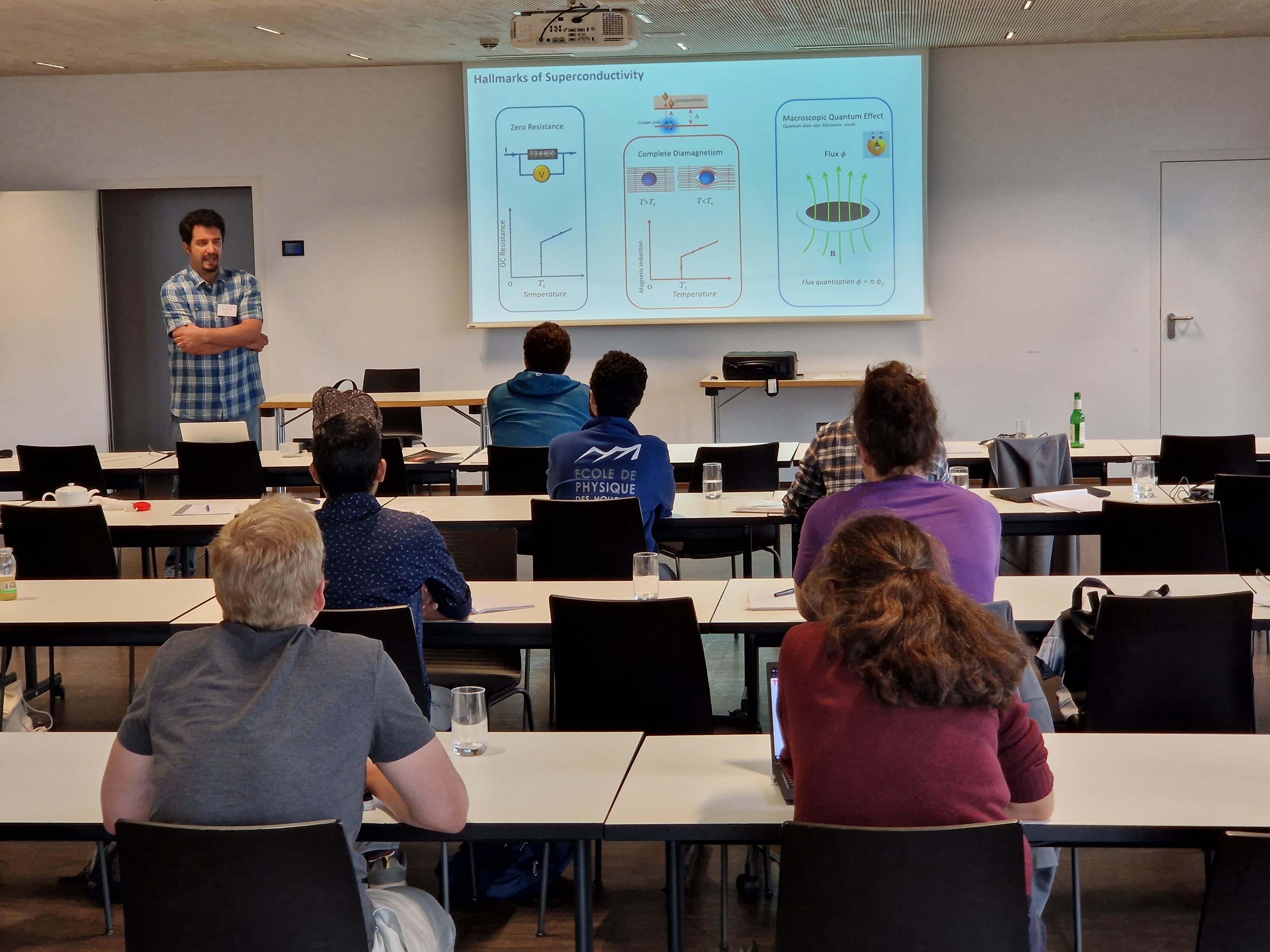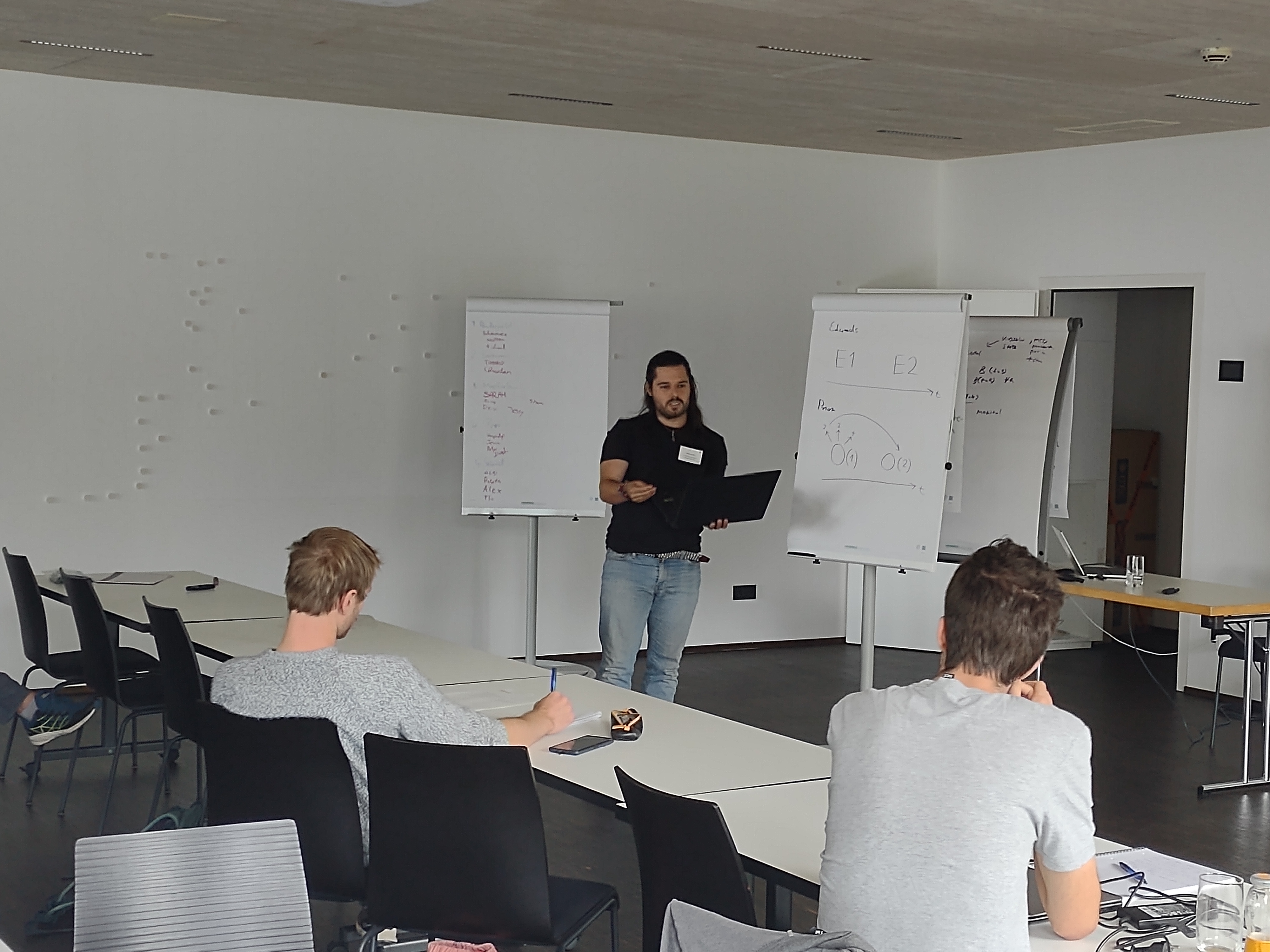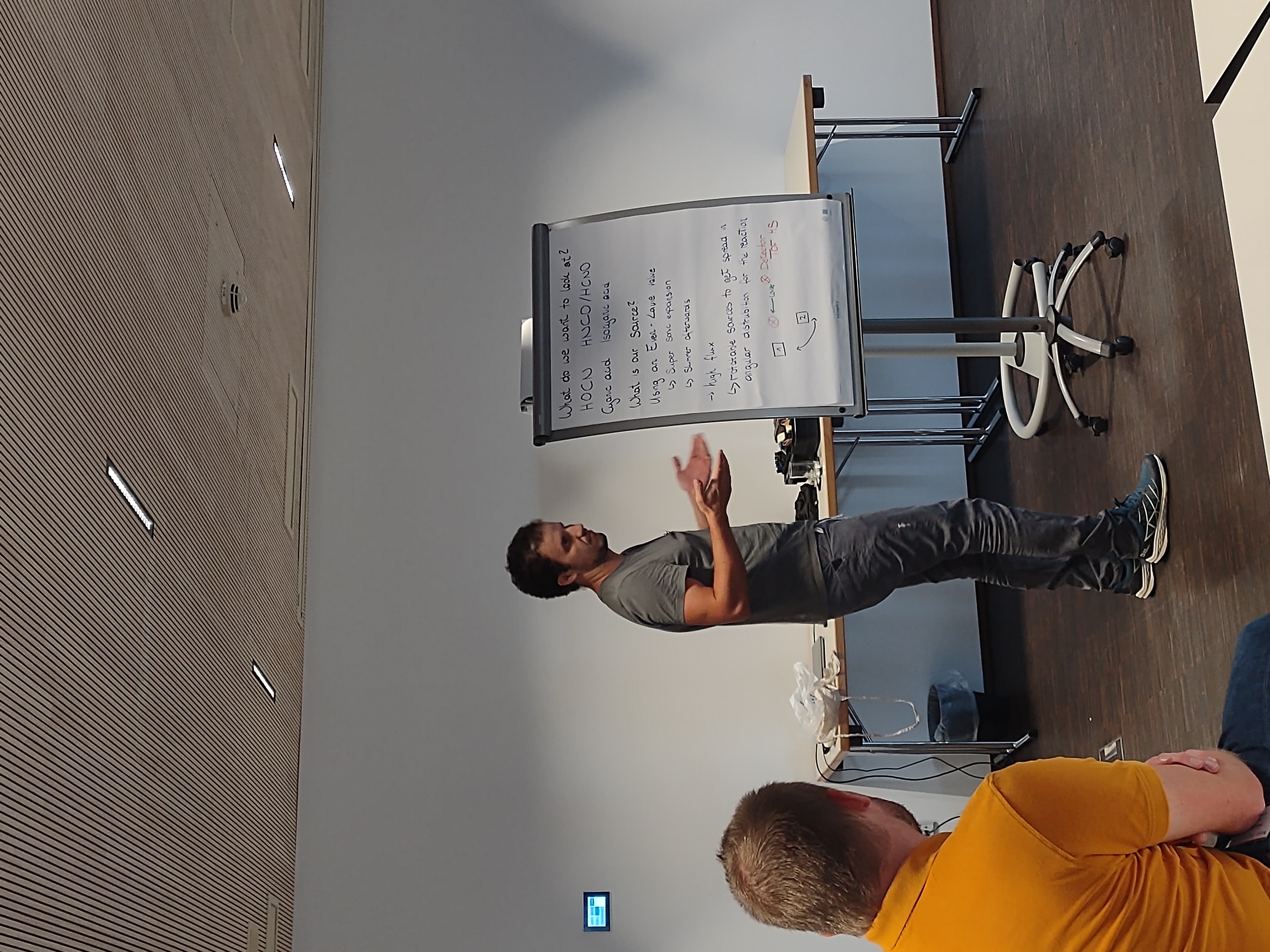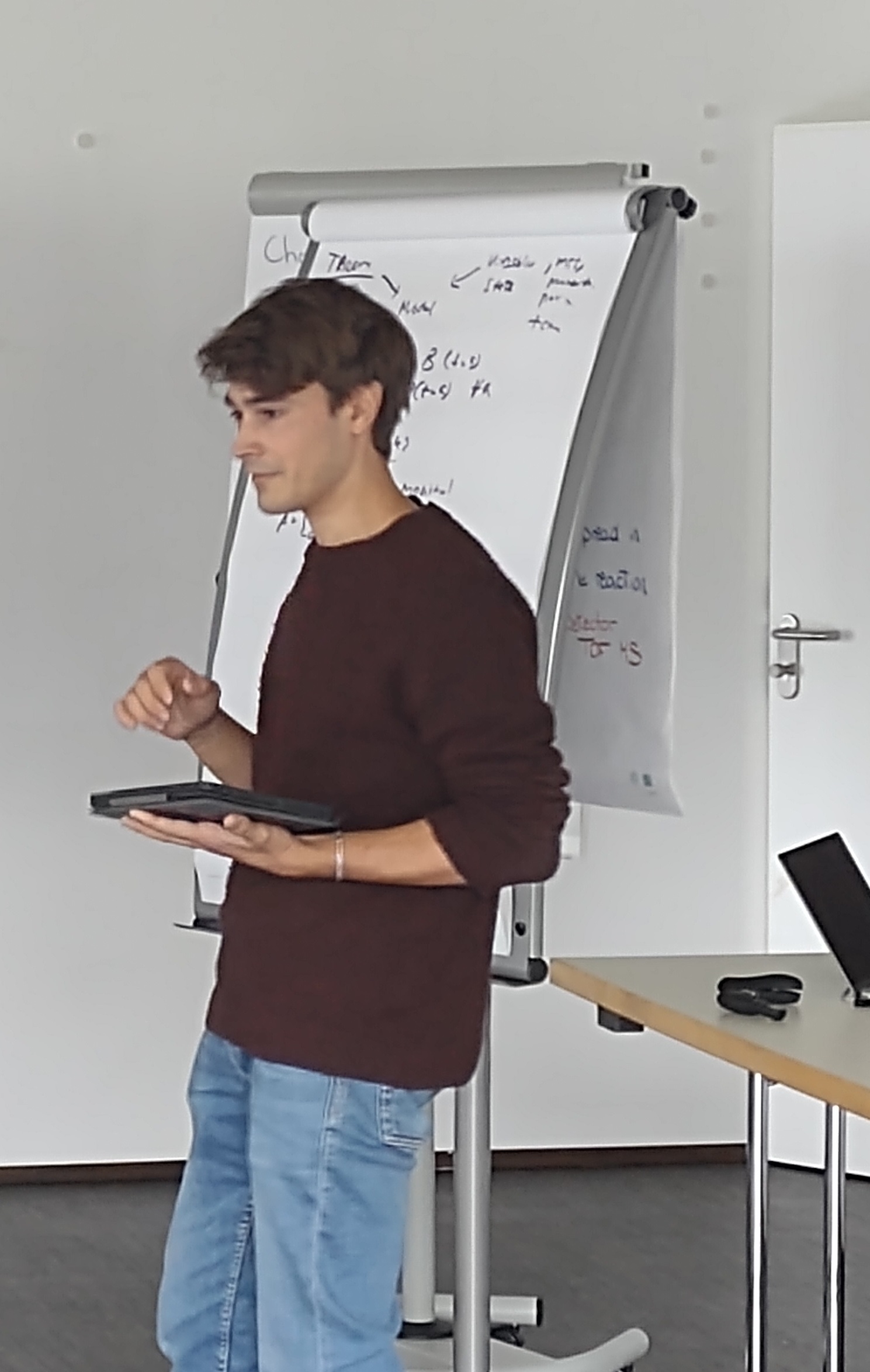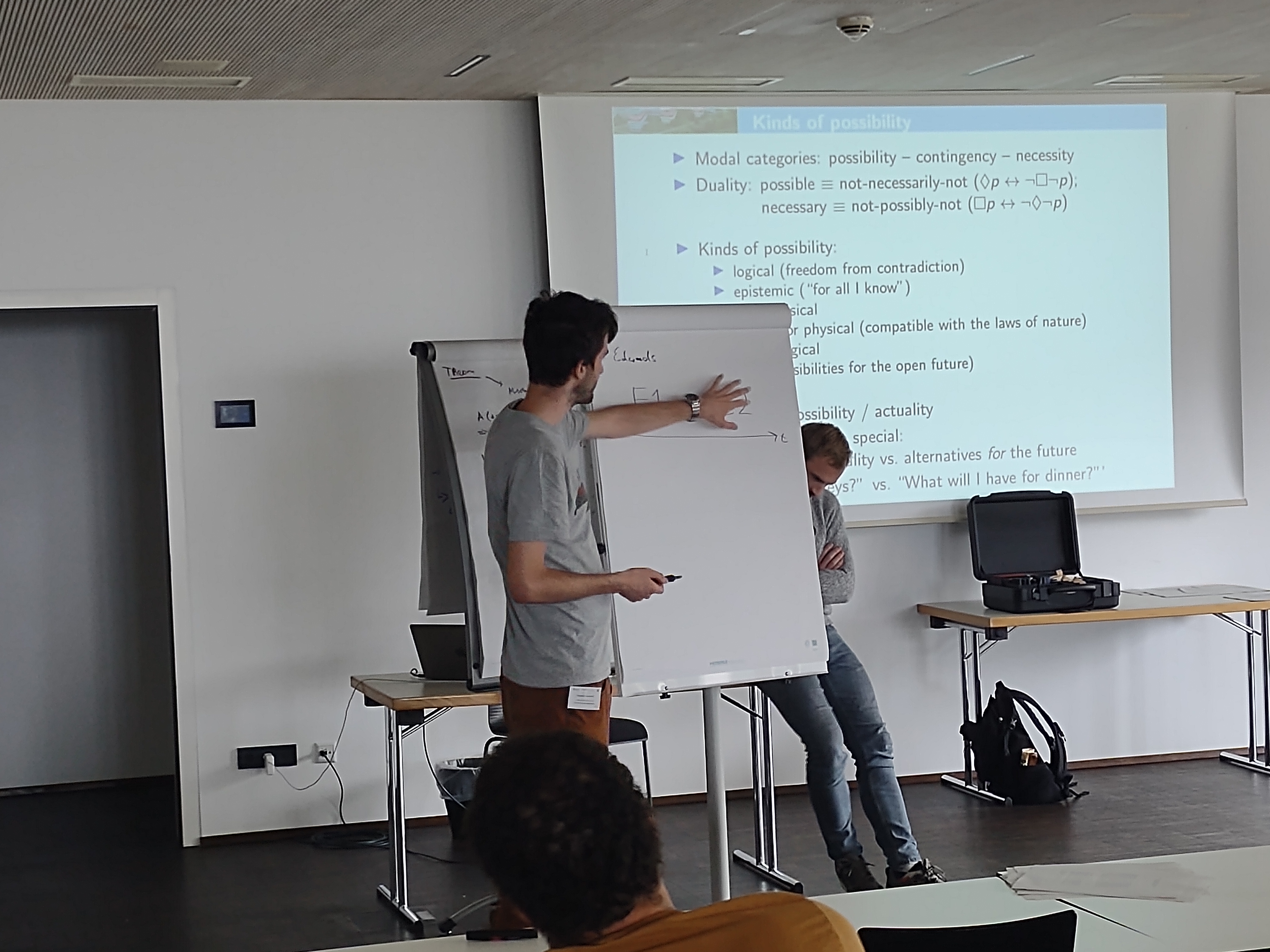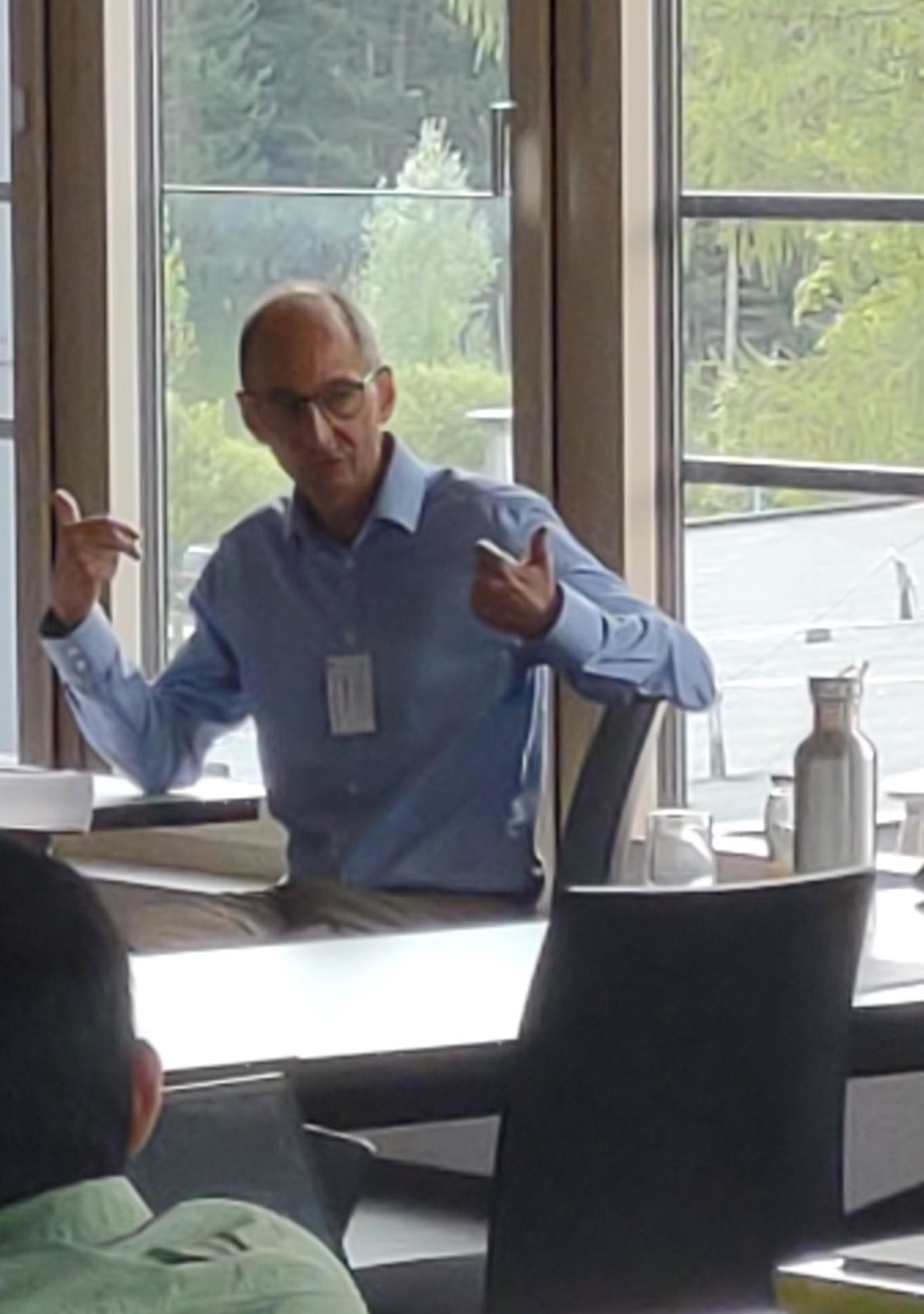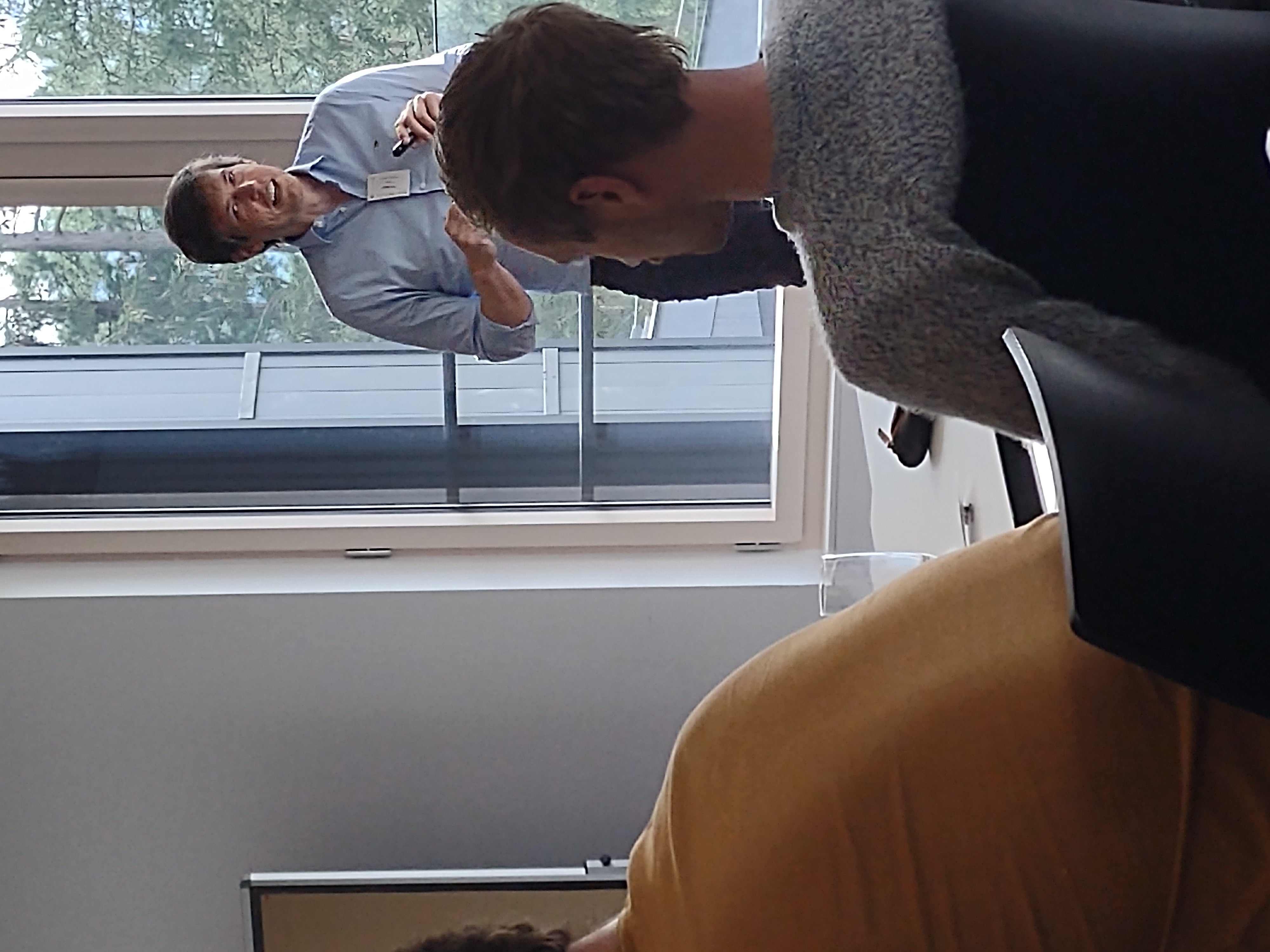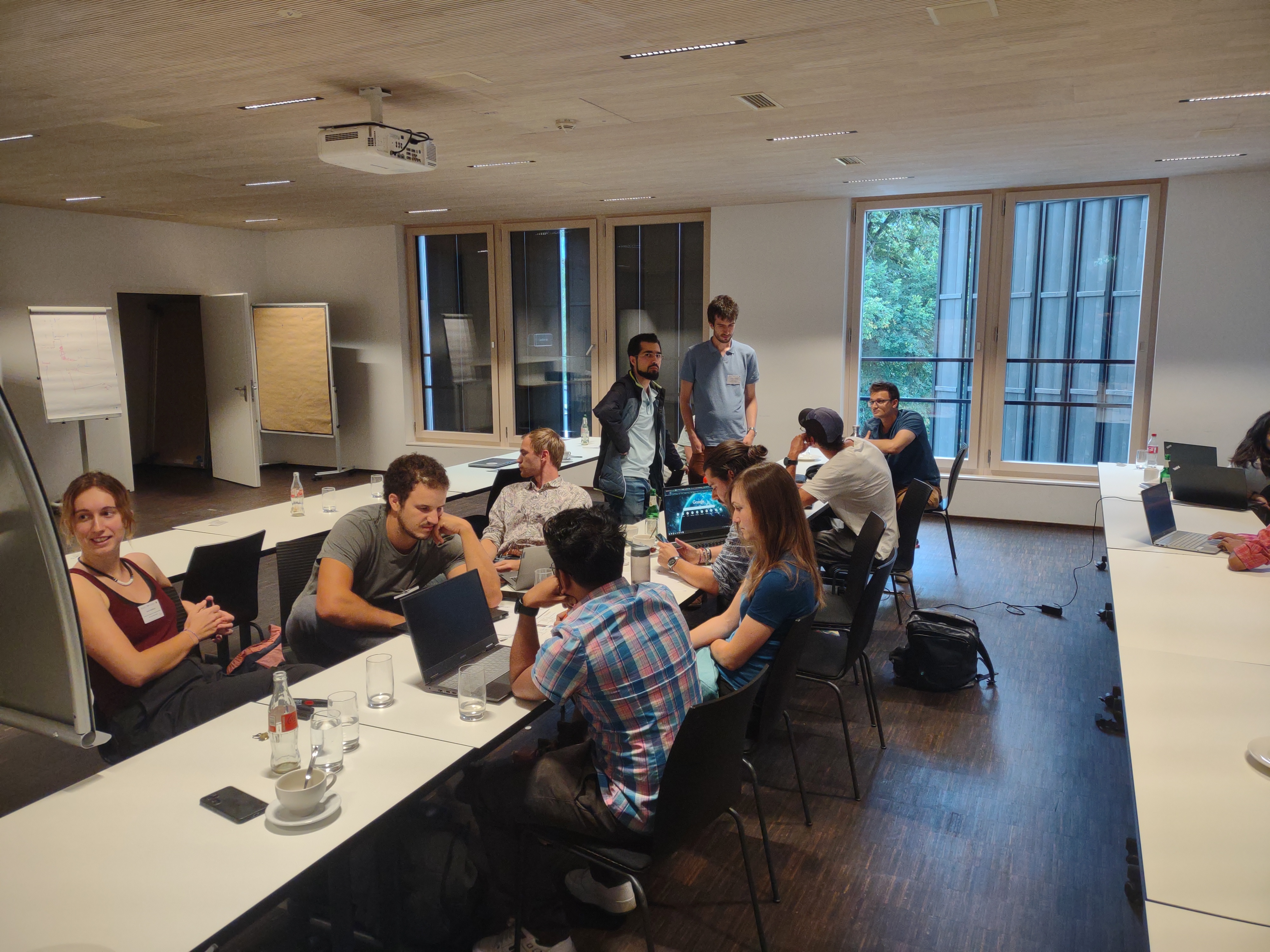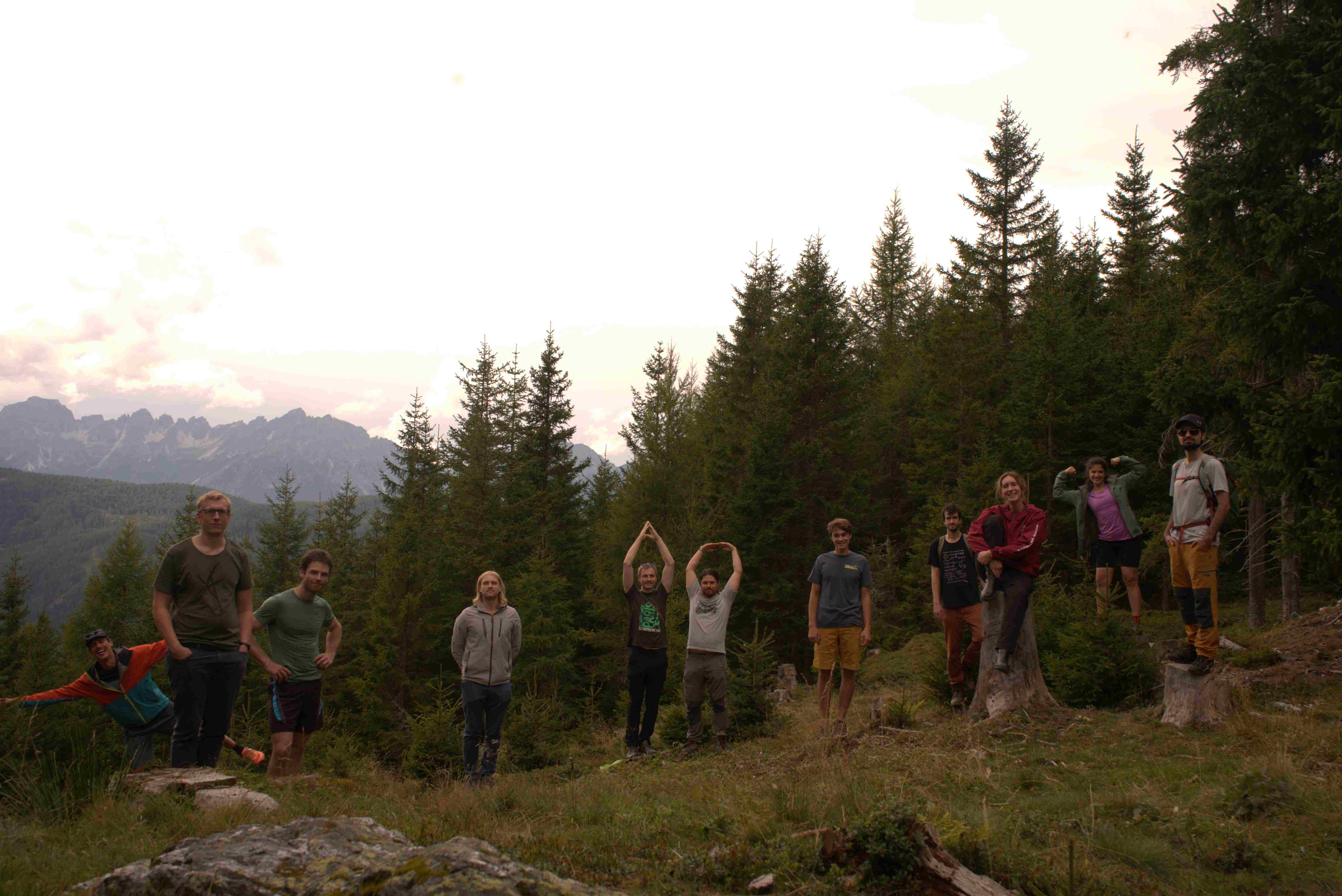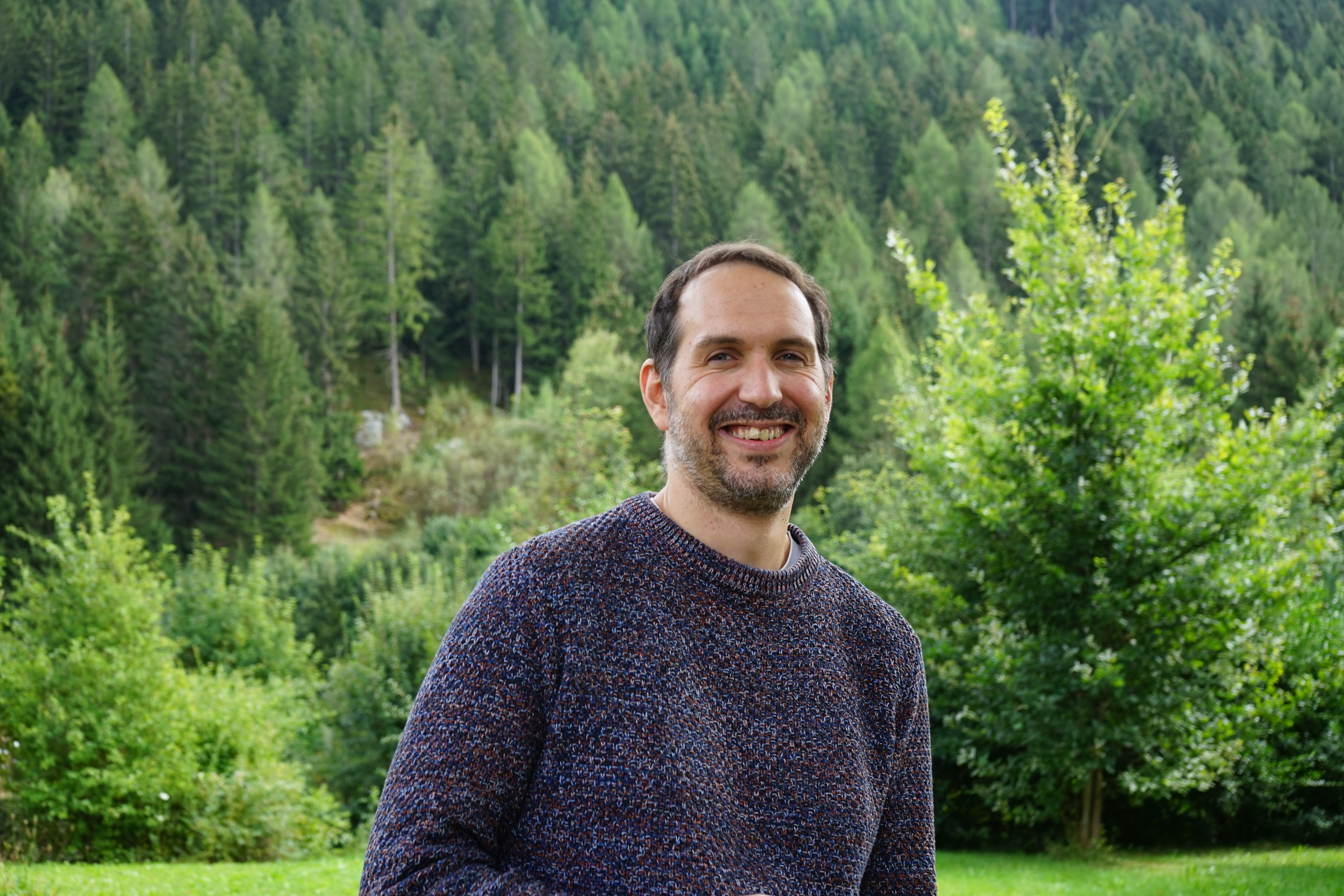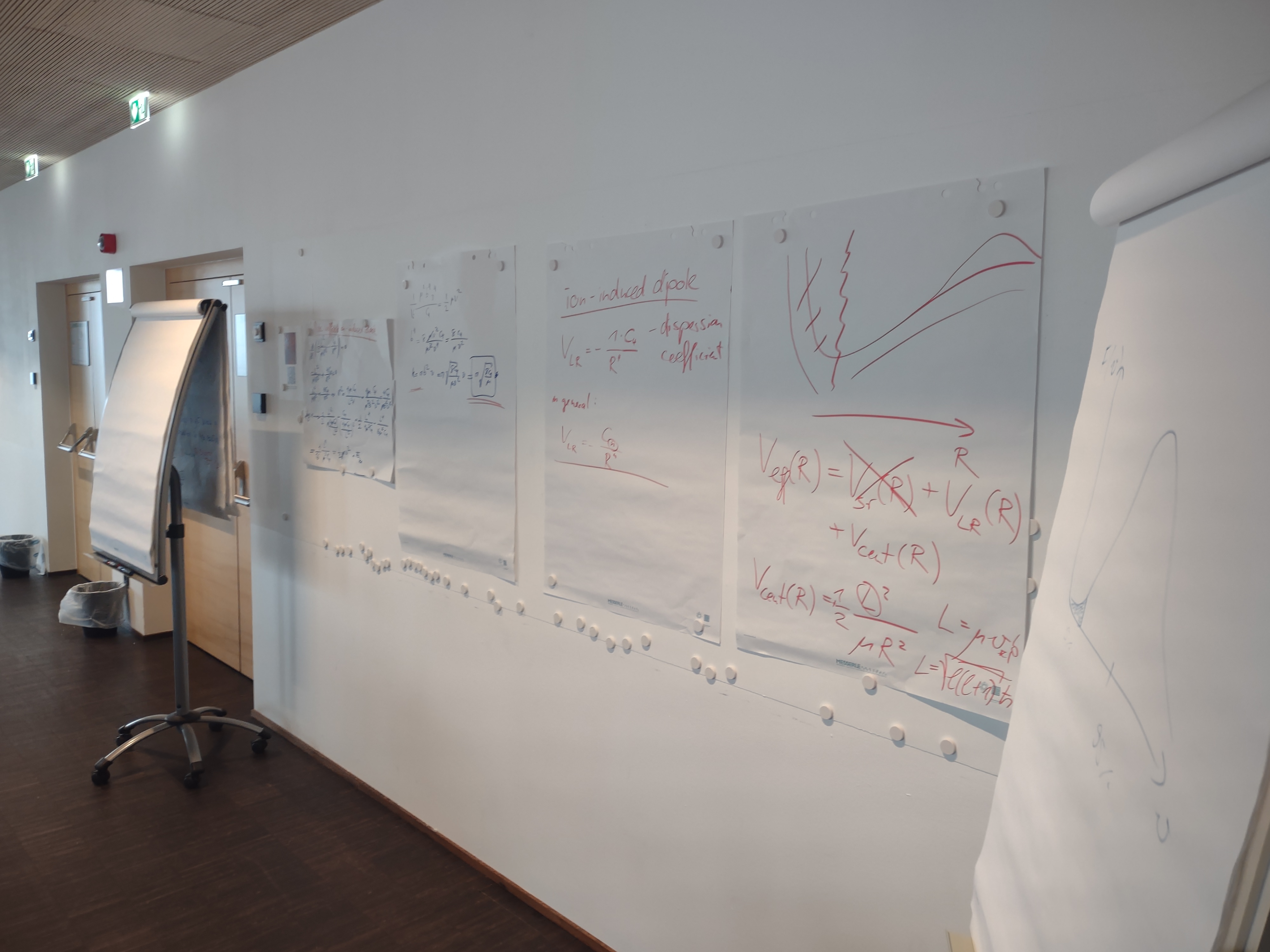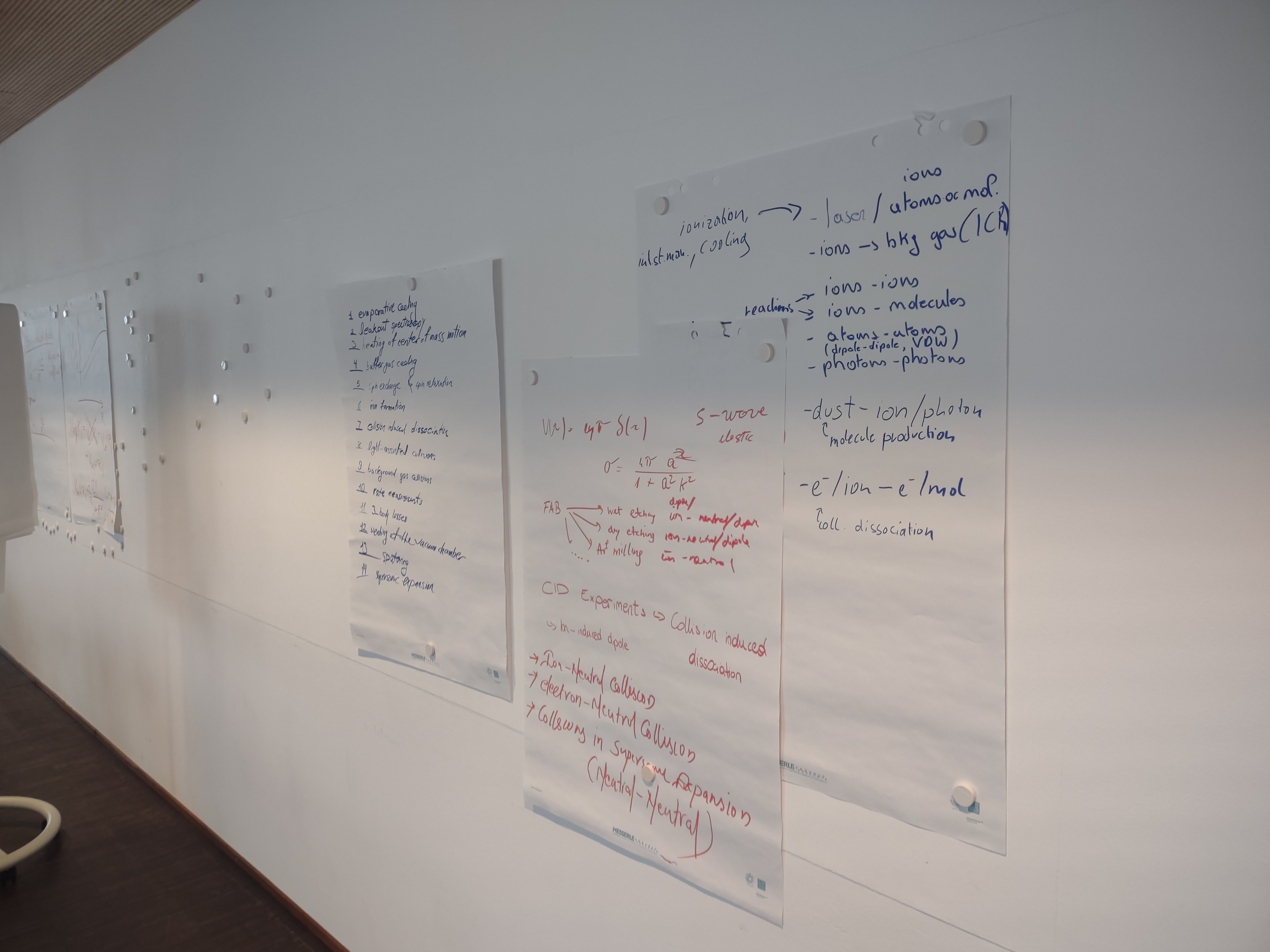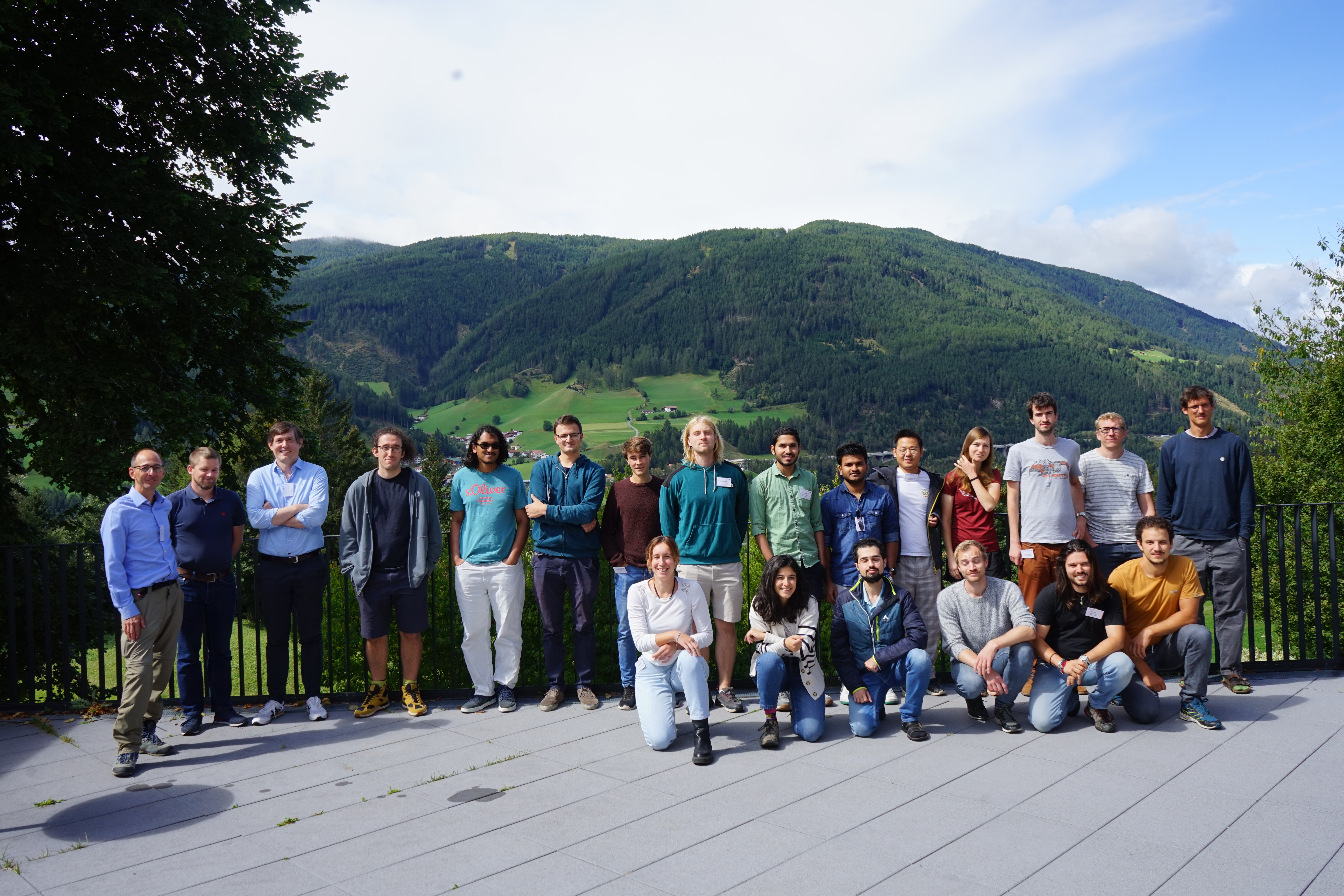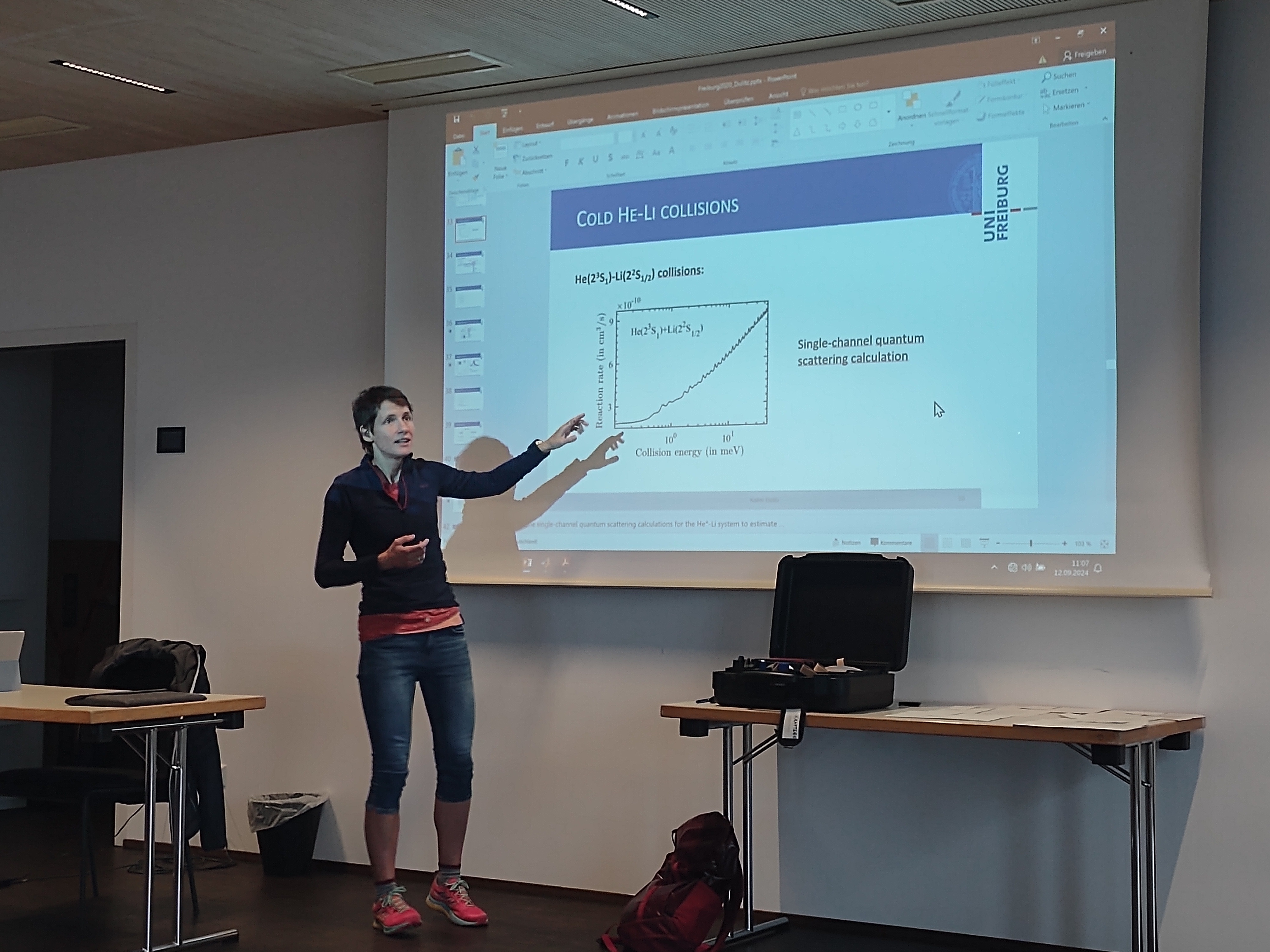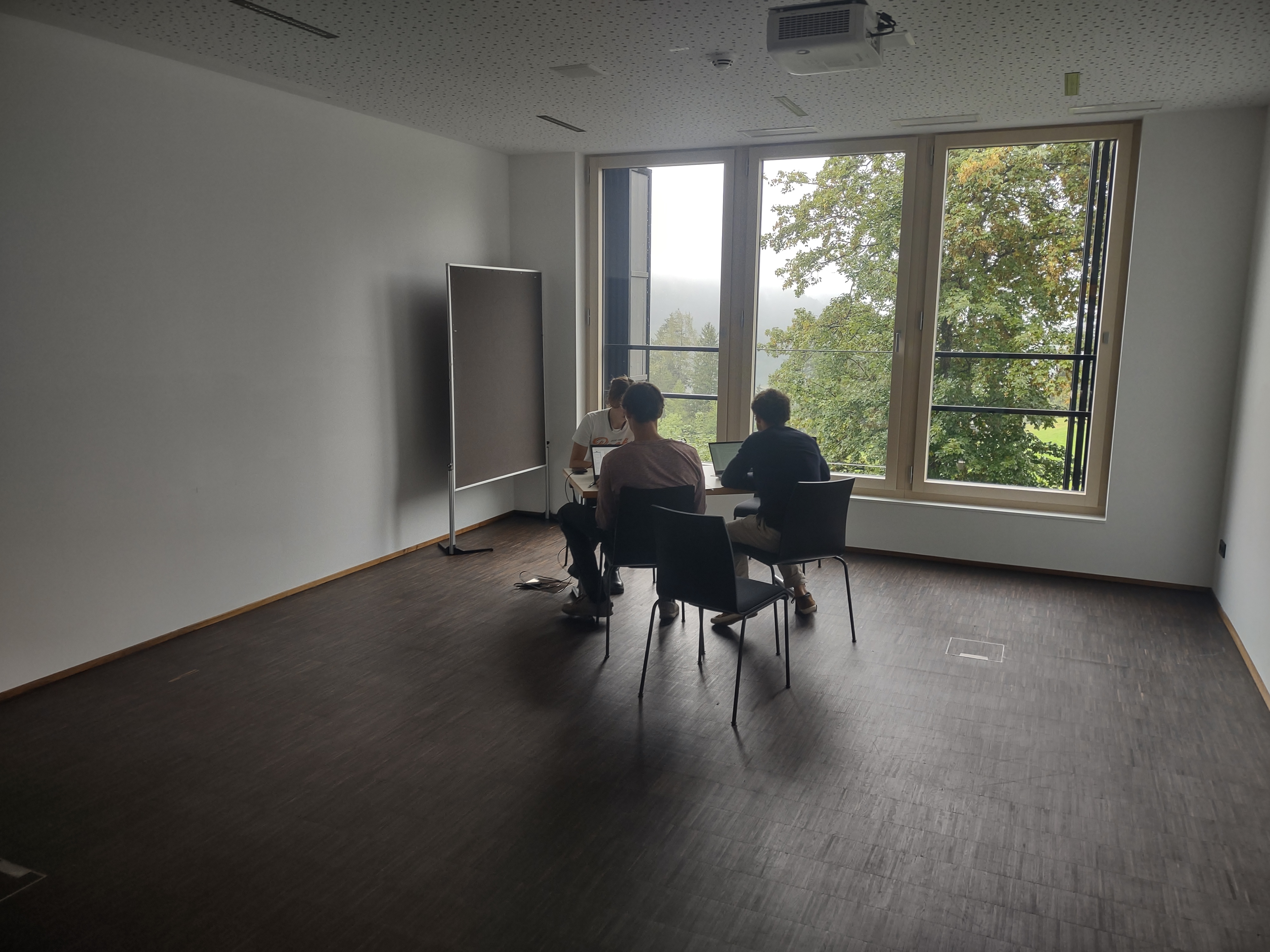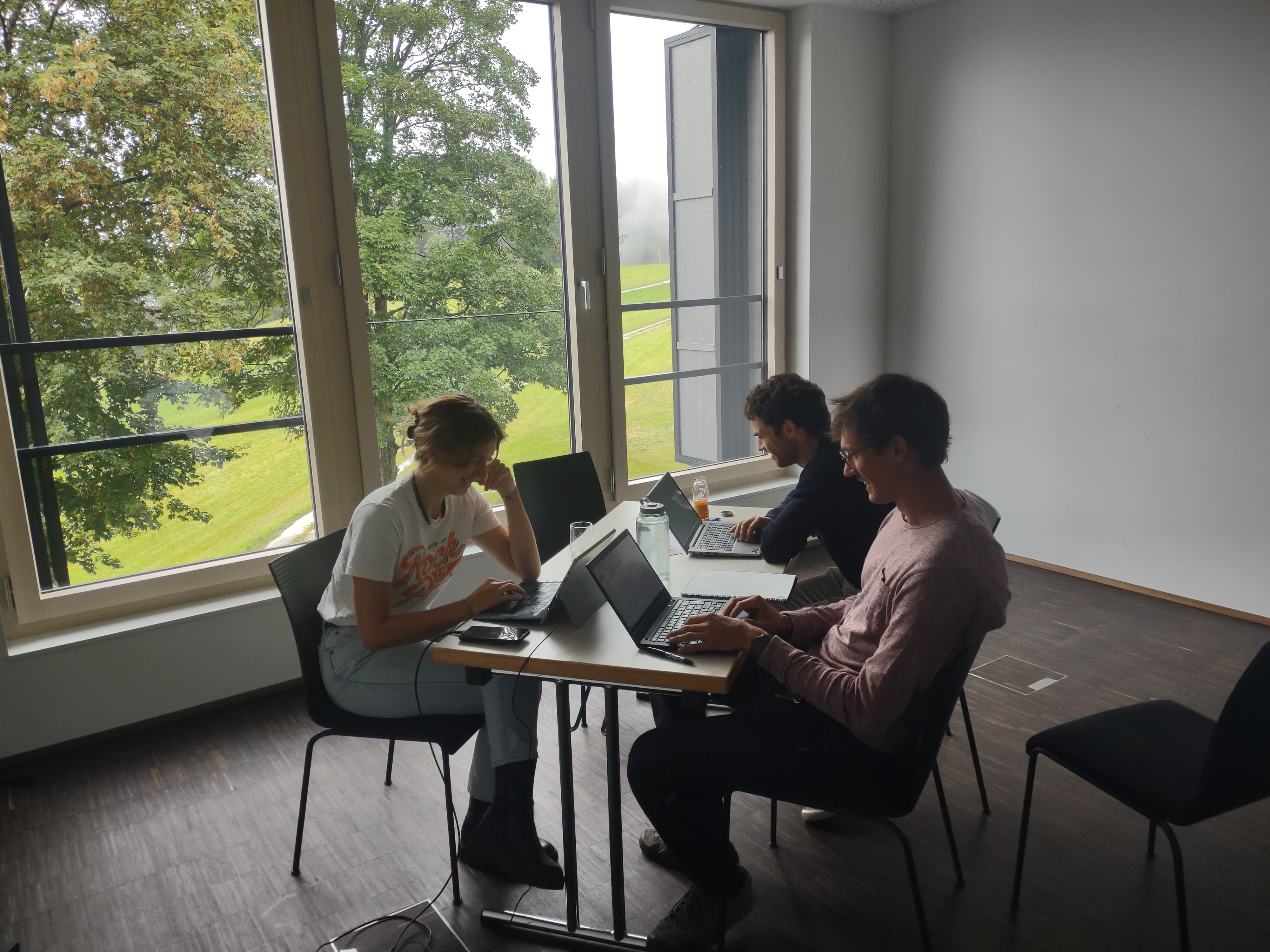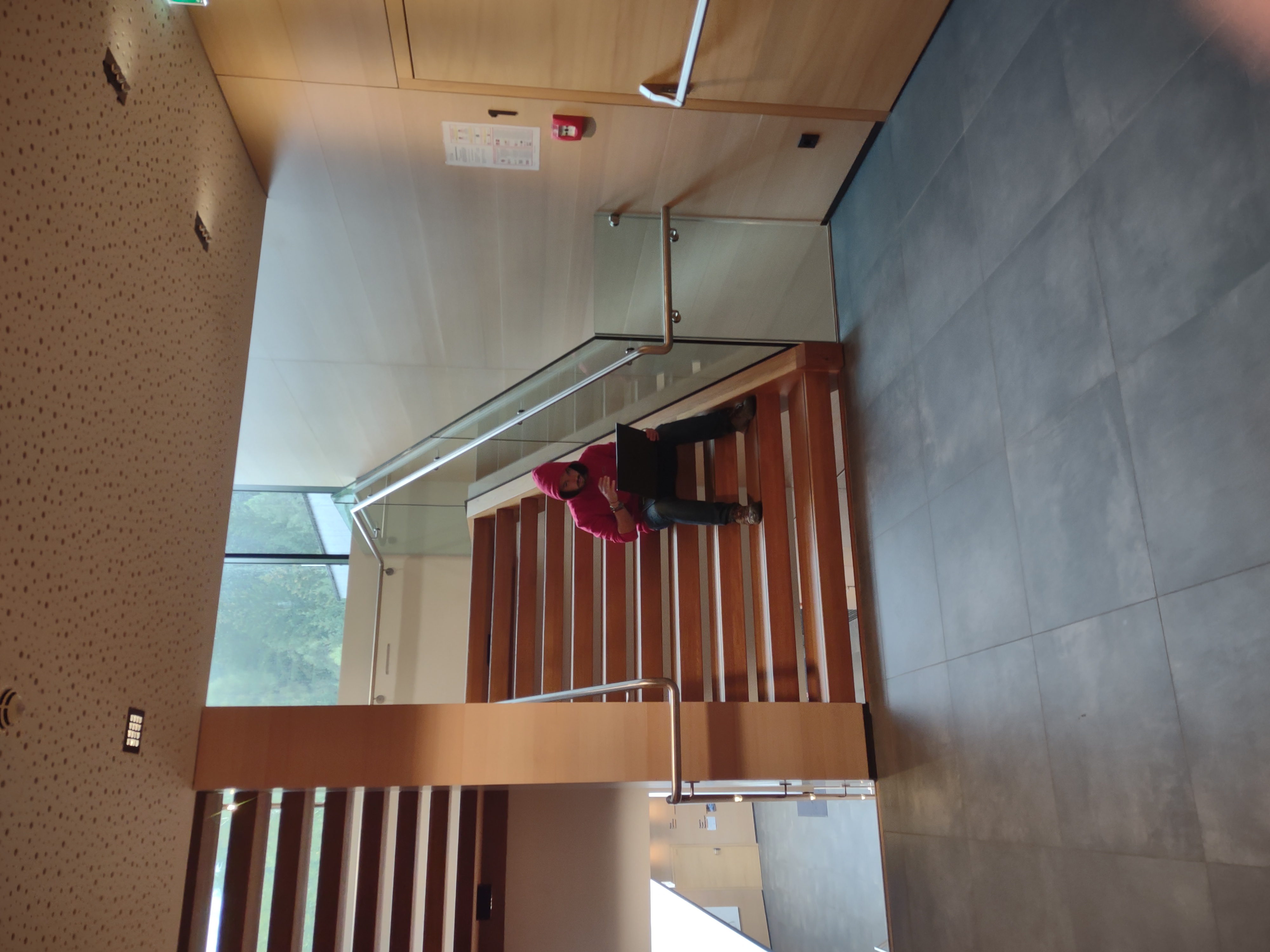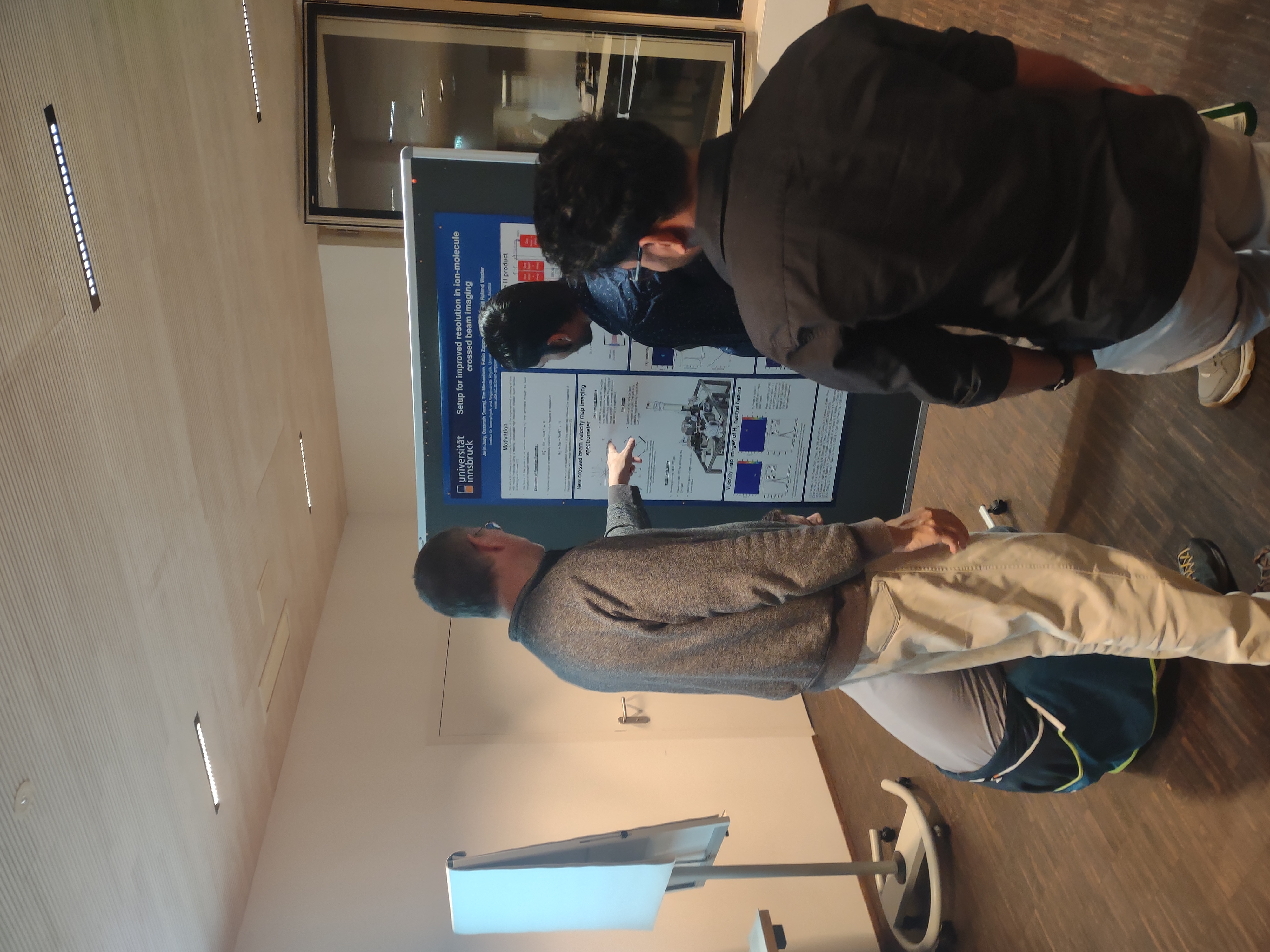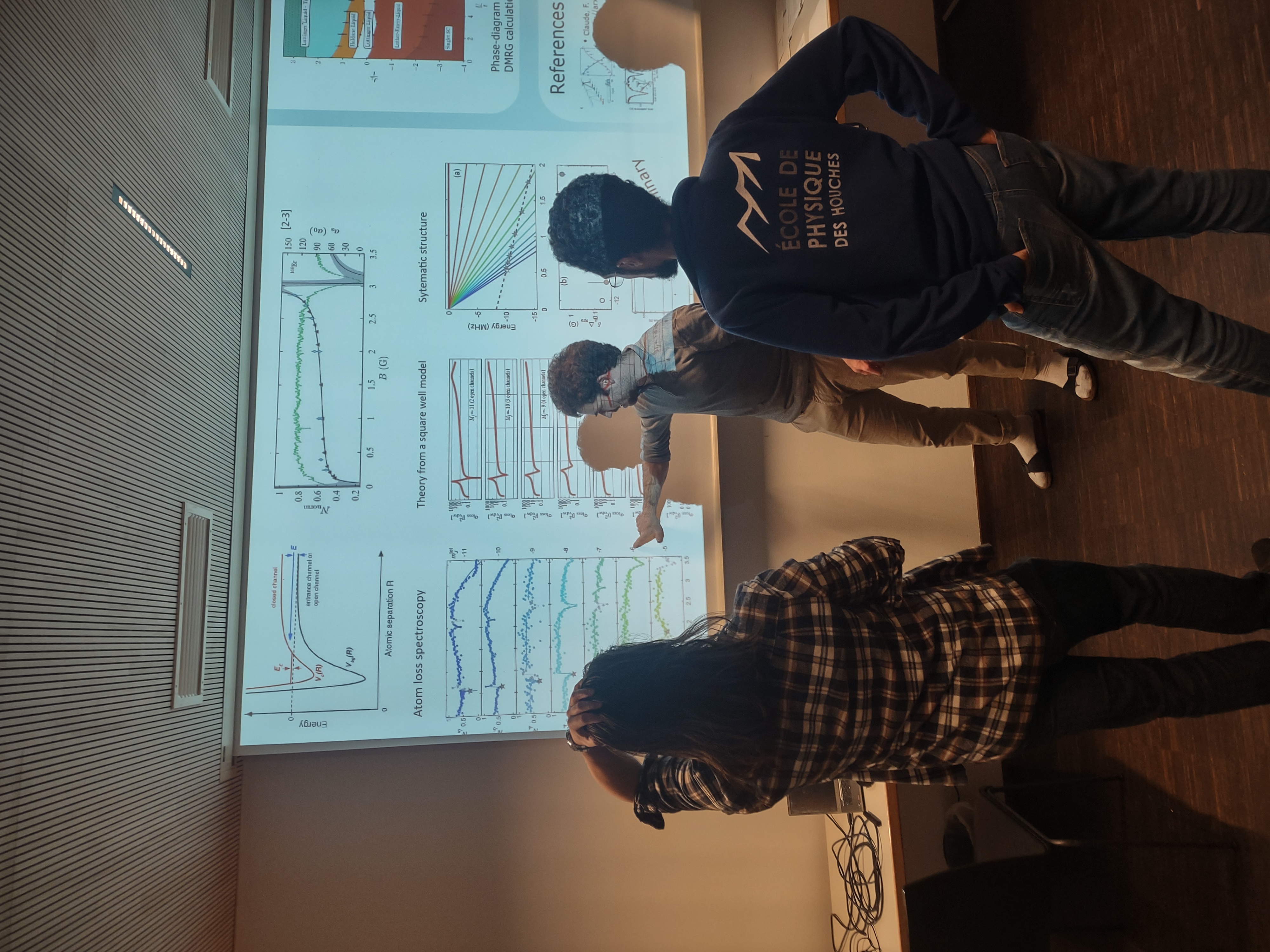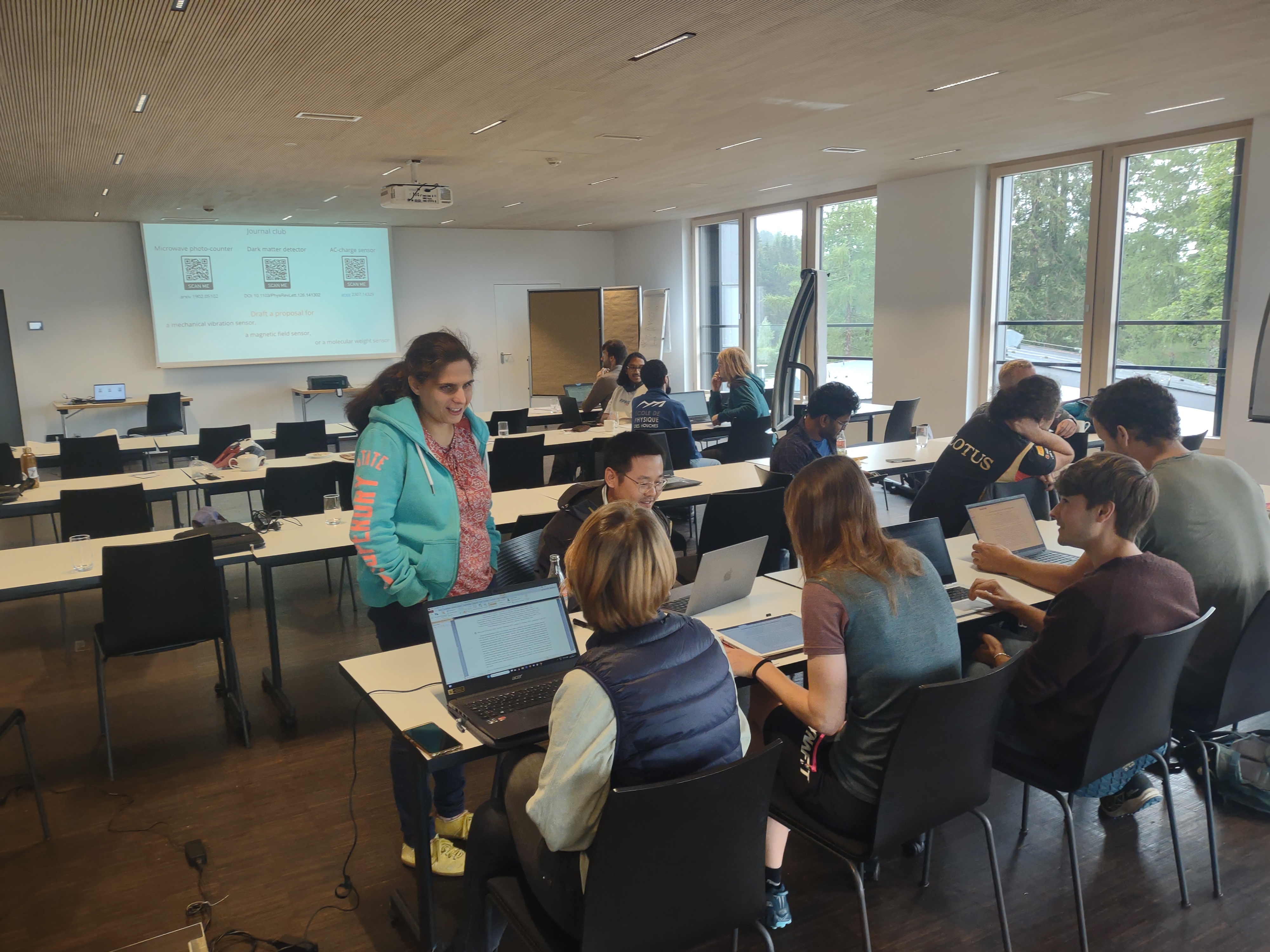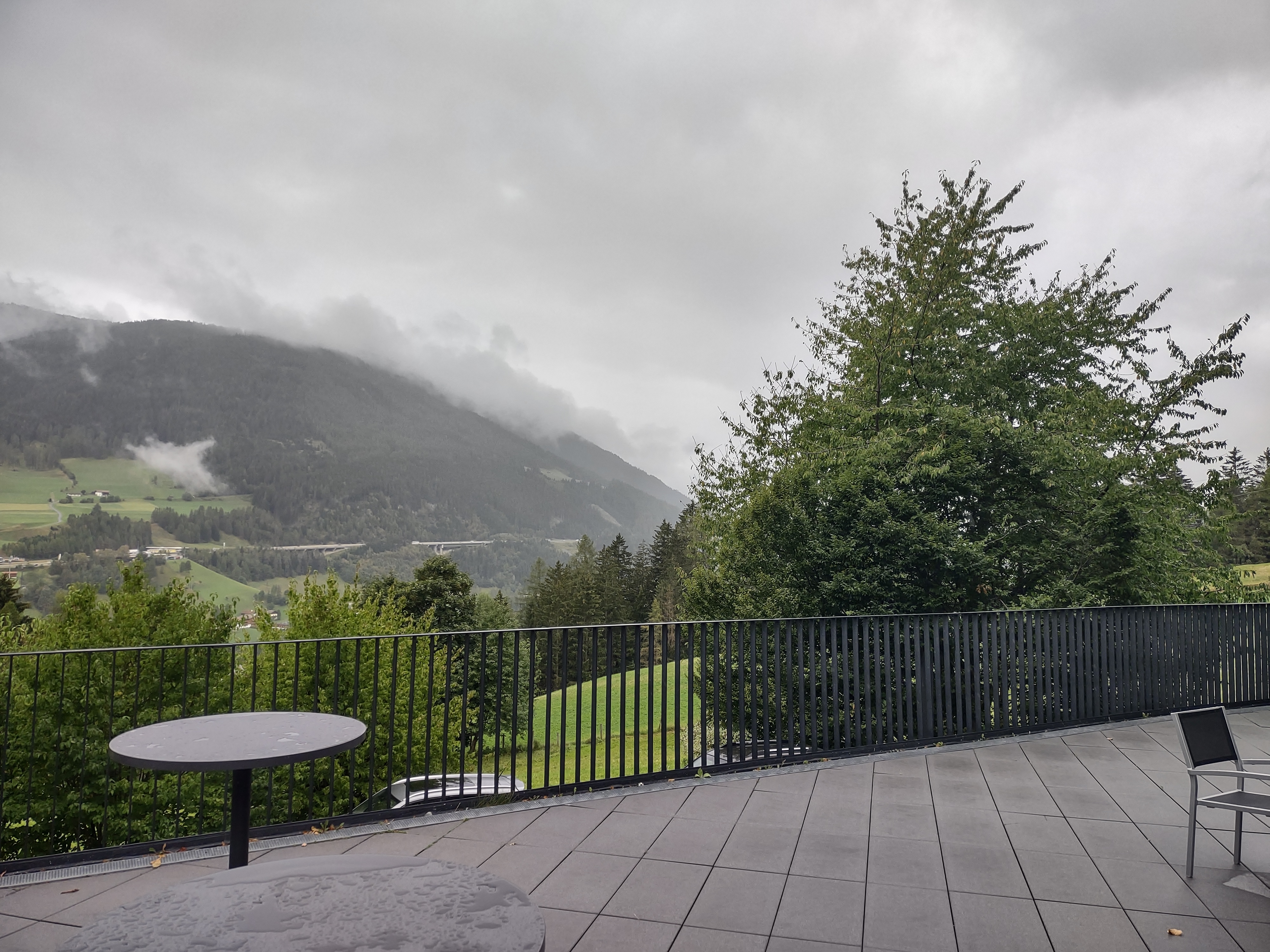Even thought the weather was rainy and a bit cold exciting workshops in a variety of areas were offered to our students. Interactive discussions between speakers and students while solving problems, as well as a paper ranking task and experimental trials were offered to our students to gain a better insight into the research area of the speakers.
Speakers
Phillip Schmid
Introduction to laboratory astrophysics
As of July 2024, more than 300 molecules have been found in the Interstellar Medium (ISM), where they serve as important diagnostics in the study of star and planet formation. Here, the molecular inventory comprises molecules as complex as 70 atoms. The presence of any molecule in the ISM – neutrals, ions, radicals – is the consequence of reactions coupled through complex reaction networks. For a better understanding of these processes detailed measurements in the laboratory are required. In the lecture Phillip Schmid introduced basic concepts of astrochemistry, focussing on the relevant processes related to molecular formation in space, highlighting also the interplay between experiment and observations, leading to new insights in astrochemistry. In this context, he presented a new experimental method to record the rotational and vibrational spectra of molecular ions in highresolution in the laboratory, a pre-requisite for astronomical detection. In the end he also showed how molecular spectroscopy can be used as a tool for the study of fundamental ion-molecular reactions relevant for space.
Tim Langen
Laser cooling of molecules
In recent years, an increasingly large variety of molecular species have been successfully cooled to low energies, and
innovative techniques continue to emerge to reach ever more precise control of molecular motion. In this lecture, the group focused on the direct laser cooling of molecules. The advances in this technique have brought into reality the capability to prepare and manipulate both internal and external states of molecules on a quantum mechanical and single molecule level, opening the field of cold molecules to a wide range of scientific explorations.
Thomas Müller
Indeterminism, the open future, and agency
Scientific practice confronts us with two views of the world that may appear incompatible. On the one hand, doing science is a
human activity that involves social interaction, decisions, and actions, much like anything else that we do seriously. We pursue science from within what the American philosopher Wilfrid Sellars calls the “manifest image” of the world. On the other hand, science is also the process of constructing a “scientific image” of the world that deviates radically from the manifest image, involving a different vocabulary, different entities, and different notions of fundamentality. The contrast between these images is especially strong in physics. In his lecture Thomas Müller focused on agency and experimentation as notions that, as he argued, constitute an interface between the images. He approached this interface by considering the question of the open future and the related contrast between determinism and indeterminism. This contrast shows up as a mathematical issue of characterising theories and their dynamical equations, but also as a conceptual issue of understanding the notion of human freedom. He provided a brief sketch of how these issues can be related via agency modelling.
Iacopo Carusotto
Quantum fluids of light
In this lecture, the group explored the physics of quantum fluids whose elementary constituents consist of photons (possibly
dressed by material excitations) confined in suitable solid-state photonic devices. They reviewed the peculiar properties of these
fluids as compared to standard fluids of material particles such as liquid helium or cold atoms and we will highlight the novel
features introduced by their intrinsically driven-dissipative nature. A special attention was devoted to their superfluidity
properties, to the on-going quest for strongly correlated states of photonic matter, and to the connections with other area of
photonic sciences like laser physics and topological photonics.
Stefan Willitsch
Cold ion-neutral interactions: concepts, techniques and applications
The recent progress in the preparation of neutral molecules and ions at temperatures close to the absolute zero point and the combination of these two domains has paved the way for a range of new research directions at the interface between AMO physics, chemistry and the quantum sciences. In the lecture, we will give an overview of the concepts and experimental methods used in this field and discuss a range of applications including cold collisions and chemistry, ion-atom hybrid systems and quantum technologies.
Kartin Erath-Dulitz
Introduction to cold and controlled chemistry
Our research in the field of cold and controlled chemistry aims to unravel the fundamental nature of chemical reactions by
carrying out experiments at low collision energies and by manipulating the quantum states of reactants. This work advances our fundamental understanding of the dynamics of chemical interactions, because it provides a clearer picture of reaction pathways that are otherwise obscured at higher energies. It also sheds light on chemical processes in the interstellar medium, where low-temperature and low-pressure conditions prevail. In this presentation, the speaker provided an introduction to some fundamental concepts which help us understand how reactions occur under these unique conditions. This included a detailed description of classical capture theory and the role of quantum tunneling through reaction barriers. Furthermore, the group applyed this theoretical knowledge in practical programming exercises, enabling participants to quantify and visualize low-temperature chemical reactivity. Moreover, Katrin Erath-Dulitz introduced various outside-the-box techniques for producing cold and controlled molecules, including bent electromagnetic guides, Zeeman deceleration, and Stark deceleration. Lastly, she illustrated some seminal applications of these methods for studying low-temperature chemistry. In practical exercises, the group examined some common machine design flaws that hinder experiments.
Kaveh Delfanazari
Superconductor Photonics
The optical information processing at the nanometer scale may be realized by tailoring and manipulating local optical electric
fields in a subwavelength domain. The interplay between electronic properties and optical response enables the realization of novel types of materials with tunable responses. Superconductors are well known to exhibit profound changes in the electronic structure related to the formation of Cooper pairs. Yet, their influence on the electromagnetic response in the optical regime has remained largely unstudied. Photonics metamaterials offer new opportunities to enhance the lightmatter interaction, boosting the influence of subtle effects on the optical response. A combination of photonics metamaterials and superconducting quantum circuits will have the potential to advance quantum information processing technologies. The given lecture covered the fundamentals and applications of lightmatter interactions in subwavelength photonic superconductor circuits, metamaterial arrays, electrically tunable superconductor photon sources, modulators, and sensors, for quantum information processing.
Reference:
[1] K Delfanazari, Advanced Photonics Research, 2400045 (2024)
[2] K Delfanazari, Nature Photonics 18 (3), 214-215 (2024)
Audrey Bienfait
Superconducting circuits for quantum sensing
Quantum superconducting circuits have shown the ability to measure microwaves with precision largely exceeding the single photon level. This ability, as well as their tremendous sensitivity to variations in their electrical or magnetic environment make them attractive candidates for a variety of sensing applications despite being confined to cryogenics temperatures : dark matter axion search, magnetometry, rare events detection, magnetic resonance spectroscopy ... In the talk, Audrey Bienfait presented
the concepts and techniques underlying these circuits, and showcase some of these applications.
Location
The Summer school took place at the

